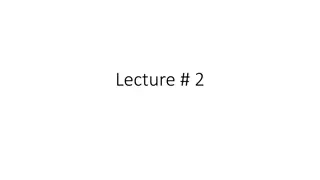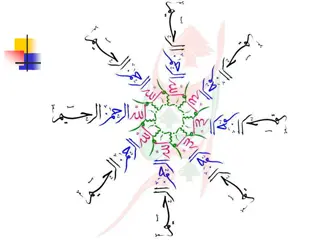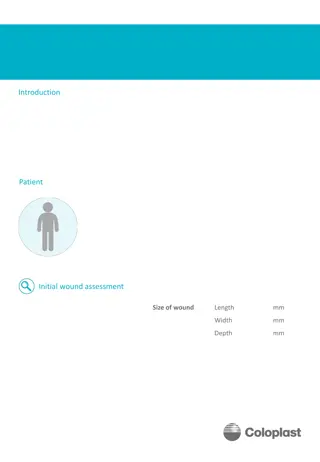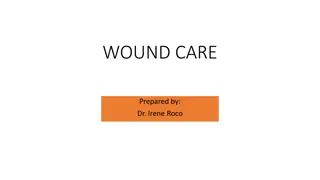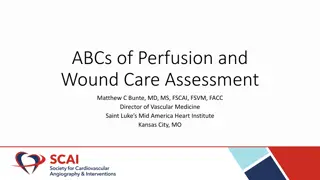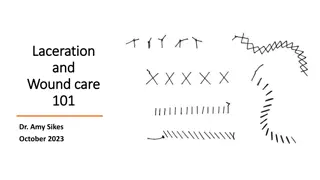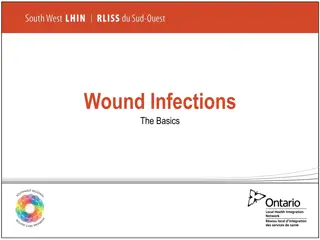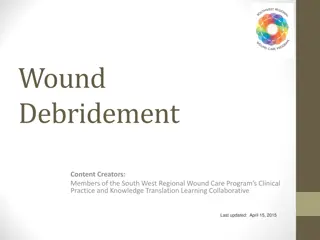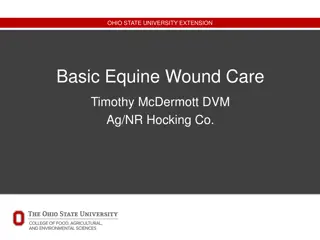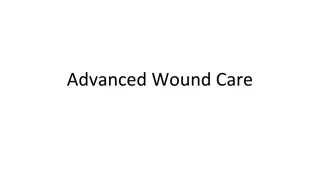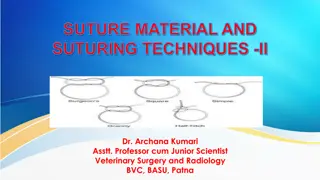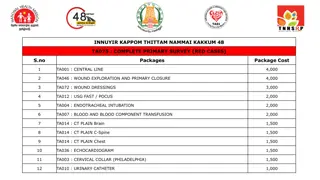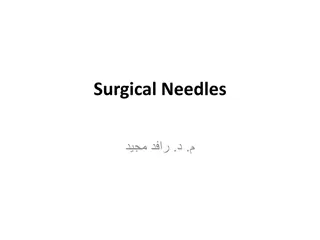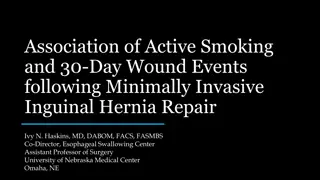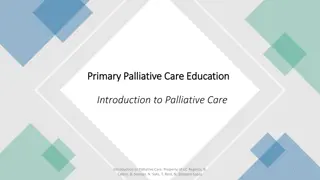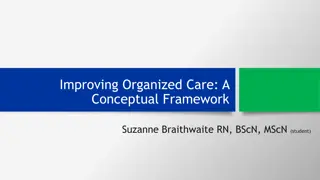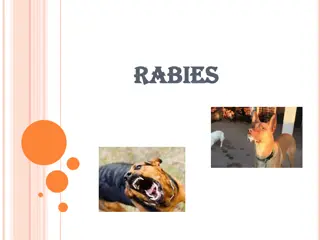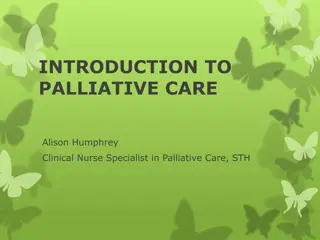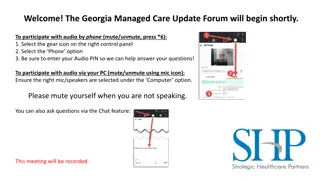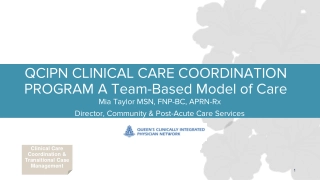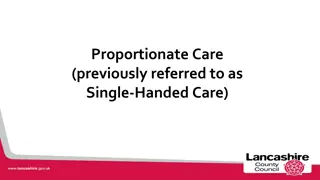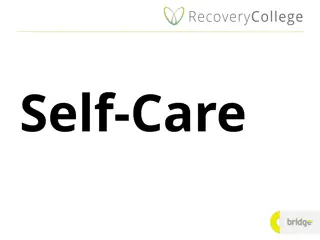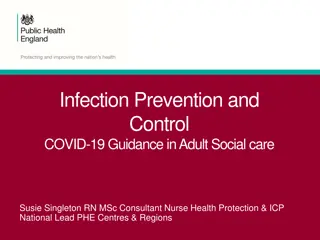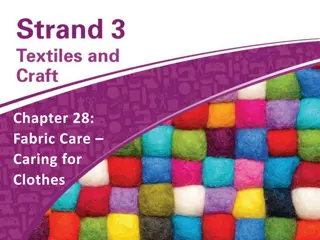Comprehensive Overview of Wound Care Strategies
Explore evaluation procedures, treatment techniques, and dressing options for wound care management. Understanding compounding factors, modalities, and proper documentation are essential. Addressing conditions like swelling, necrosis, venous and arterial insufficiencies, and diabetes management play crucial roles in promoting effective wound healing. Additionally, maintaining controlled blood sugar and pressure levels, adequate protein intake, and proper wound care protocols are highlighted.
Download Presentation

Please find below an Image/Link to download the presentation.
The content on the website is provided AS IS for your information and personal use only. It may not be sold, licensed, or shared on other websites without obtaining consent from the author. Download presentation by click this link. If you encounter any issues during the download, it is possible that the publisher has removed the file from their server.
E N D
Presentation Transcript
Created by L. Michelle ONeill as part of an independent study with the Physical Therapists at WakeMed Wound Care Clinic
To understand evaluation procedures, treatment techniques and dressing options To understand management of compounding factors To understand indications for various modalities To understand documentation of wound care
Swelling Compression Necrotic Debride Venous Insufficiency Decrease swelling via compression Arterial Insufficiency Re-establish blood flow Pressure/Diabetic Offload
No Smoking Controlled Blood Sugar Controlled Blood Pressure Adequate Protein Intake
Indicates past 3 days level of protein Should be >20 Normal 18-38 mg/dL Gives a longer indicator of protein Need extra protein to heal the wound AND Drainage from wound leaks out protein
3 month indication of sugar level Bacteria feeds off sugar Leads to infection! ABI should = 1.0 ABI should be triphasic
Gauze with Normal Saline Inexpensive Great for wounds changed daily Commonly Used For: packing abscesses or deep cavity wounds
Fever Spreading erythema of periwound .. GO TO ER!
Great for cavity wounds Wound must be free of necrotic tissue before a wound vac can be applied Negative Pressure creates angiogenesis, removes drainage, and assists in achieving wound closure
Must consider: location of wound, if heavily bleeding, venous stasis, enteric isolation, suture lines, in ICU, intact dry eschar, mulitple wounds. Indicated for lymphedema!
Loosens tissue to enable more effective debridement Indicated in wounds with odor
4 Medicare approved Dxs for OP setting Diabetic Foot Ulcers meeting 4 criteria Chronic Refractory Osteomyelitis Preparation and preservation of comprised skin grafts and flaps Late Radiation Tissue Injury
Mechanism of Action: Direct Pressure Hyper-oxygenation Angiogenesis Anti-microbial Effects Vasoconstriction Reduction Ischemia-Reperfusion Injury
DilutedBleach Use on foul smelling, highly necrotic wounds Is non-selective do not use on patients with healthy granulating tissue!!!
Use for wounds infected with pseudomonas Sweet odor, BRIGHT GREEN/blue drainage Use both Dakins and Acetic Acid for 5-7 days or longer depending on drainage, odor, and appearance
Use on 1-2 times on wounds with heavy, adherent biofilm Is non-selective do not use on patients with healthy granulating tissue!!!
Antimicrobial Use on green or brown necrotic wounds Silvasorb- slight debridement Silvadene- contains sulfar and silver, keeps wound bed moist, helps dead tissue to slough off, not a debriding agent, good for burns, removes from wound easily
Acticoat Absorbant Silver- silver alginate, becomes a gel that absorbs drainage, cleans wound, can stay applied for 1 week to absorb drainage Some people react to silver if it burns, take it off!!! Turns gelatinous as it soaks up drainage Cannot use in patient s allergic to seaweed!!!
Acticoat Flex= silver impregnated fabric. Stretchy, can stay in place 7 days max Acticoat Absorbant= silver impregnated calcium alginate Can in stay in place 7 days Good to put under a cast
Cauterizes hypergranulation tissue buds to enable skin to cover evenly
Debriding agent for necrotic wound This is an expensive dressing Does the patient have insurance to cover the cost???
Decreases infection Absorbs drainage Debriding agent
Wicks drainage away to foam Foam is a reservoir If changing dressing daily, use wet-to-dry and ABD pad instead!!!!! More cost-effective
Mesalt-salt Inexpensive debriding agent Xeroform- Iodine Does not stick to skin, great for skin tears Toxic to healthy tissue Adaptic- vaseline
Silicon-covered foam Meant to be able to lifted to check wound and stuck back down Meant to stay on for several days
Protects and offers minimal amount of absorbency Good for stage II pressure ulcer, denuded periwound skin, or skin tear
Film, offers no absorption Good for skin tears and to protect graft donor sites
What is the cause of the wound? Is the wound bed wet or dry? Does it need cleaning/removal of necrotic tissue? 1. Use silver (antimicrobial) for chronic wounds with light odor/light yellow biofilm 2. Use debriding agent for a large amount of necrotic tissue 3. Use non-selective topical solution if FOUL SMELLING and MAX amount of necrotic tissue
History of the wound How has the patient been treating it at home Ask and then EDUCATE about barriers to healing Who will do dressing changes at home
Drainage (amount, color, and odor) Wound bed (% amount of granulation tissue vs necrotic tissue/fibrin/slough) Location Measurements Presence of tunneling/tracts/undermining (described by position as it relates to a clock, with patient in anatomical position)
Borders Periwound Denuded= raw Macerated= wet Indurated= hard, woody Edema (with girth measurements if needed)
What you tissue was debrided, why, what tools you used Ex: debridement of scab, peeling skin, and yellow slough with forceps Always document how many pieces of gauze are applied How many pieces of foam for wound vac
When describing drainage, consider how long dressing has been on and how big the wound is/where it is If too much drainage, need more absorptive drainage If no drainage, need to keep wound bed moist with gel
Example Assessment: __ year old _(male/female)_ with _(decub s/p I&D)_. Describe wound. What you did. What he will need/why he would benefit from skilled therapy services. POC. D/C.
Per FACES scale= for pain scale when the patient cannot or do not rate pain
Charges: Eval WD vac< or > 50 cm2 SD < or > 20cm2 WP, MT, SC PT multi-layer wrap PL kit Supplies- from database picklist
Use on plantar wounds, most often for Diabetic Foot Ulcers Off-loads wounds to evenly distribute pressure
1) Cotton between toes 2) Stockinette- cut out top of ankle crease 3) Pad top of foot/toes, malleoli, and anterior tibia 4) Roll on Webril, pad bottom of foot and Achilles 5) Plaster- 1st heel, 2nd toes, (2) 3 inch rolls 6) Blue fiberglass- (3) 4 inch rolls. Cover all plaster. Go up leg and reinforce weak parts; i.e. back of ankle and toes
Forefoot off-loading shoe Heel off-loading shoe NWB with AD Cam Walker boot, post-op shoe Pelvic Pressure ulcers; limit OOB Foot/Plantar/Toe wound; limit weight bearing
Use on heavily draining wounds Profour= 4 layer wrap ABI > 0.8 cotton layer, 1 short stretch, 2 long stretch Profour Lite= 3 layer wrap ABI between 0.6-0.8 cotton layer, 1 short stretch, 1 long stretch
Coban 2 and Coban 2 Lite= for patients with lymphedema and venous leg ulcers Indicated for: Irregularly shaped legs Morbidly obese patients Active patient that needs to wear shoes Patient with latex allergy/sensitivity
Coban 2 ABI > 0.8 2 short stretch layers Coban 2 Lite= for patients less tolerant of compression ABI between 0.5-0.8 Short stretch, apply at full stretch
Kerlix and Coban For heavily draining wounds that need frequent dressing changes Wounds contaminated with pseudomonas needing acetic acid dressings Patients needing mild compression, unable to tolerate other wraps
Like all other areas of PT. Use clinical reasoning AND COMMON SENSE!!!! Identify the cause and address it Patient education for barriers to healing Choose your dressing and treatment method
All Information was gathered during an independent study at WakeMed Wound Care Clinic and was provided by Christina Young, PT; Cindy Wulffhaver, PTA; and Tara Marshall, PT


